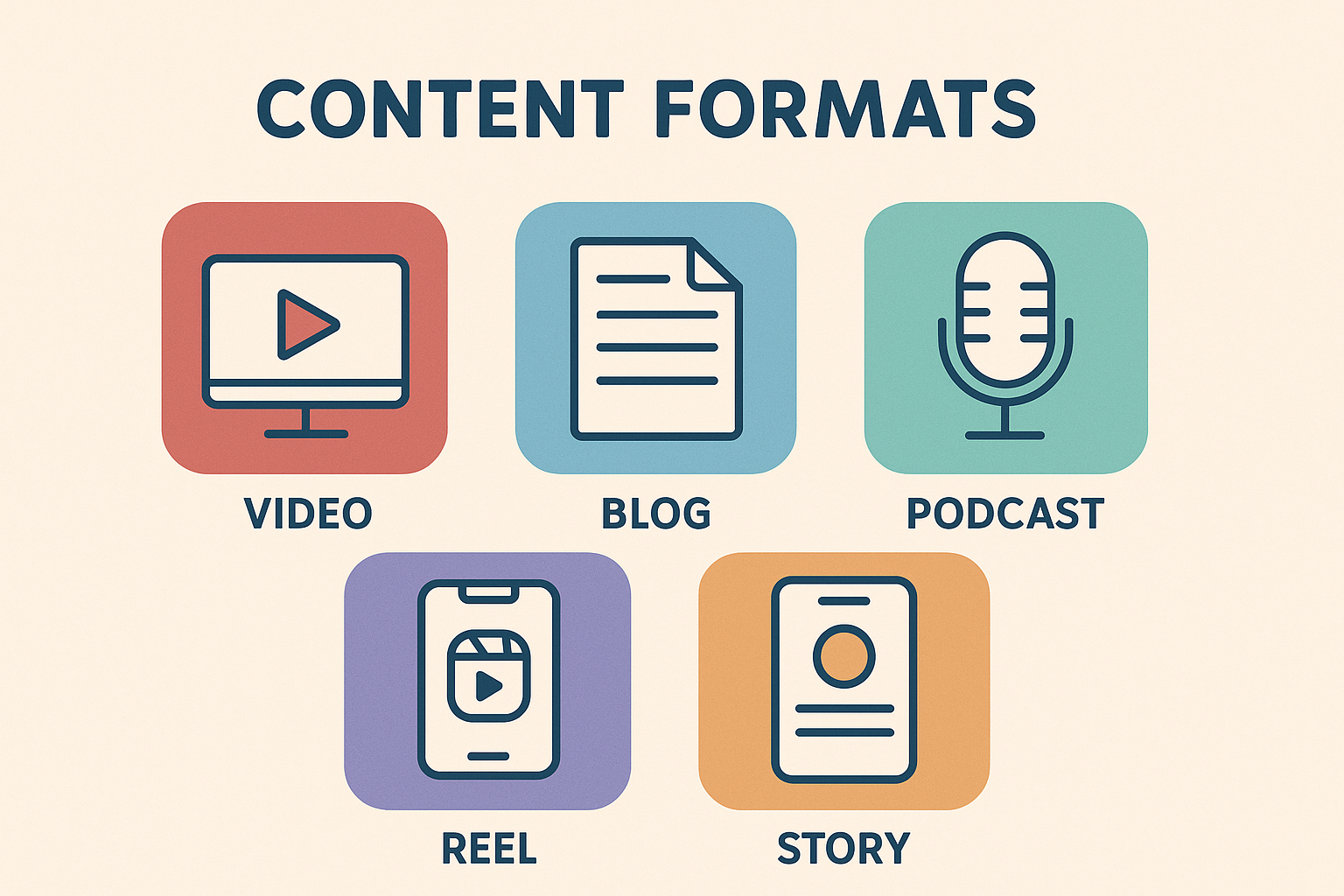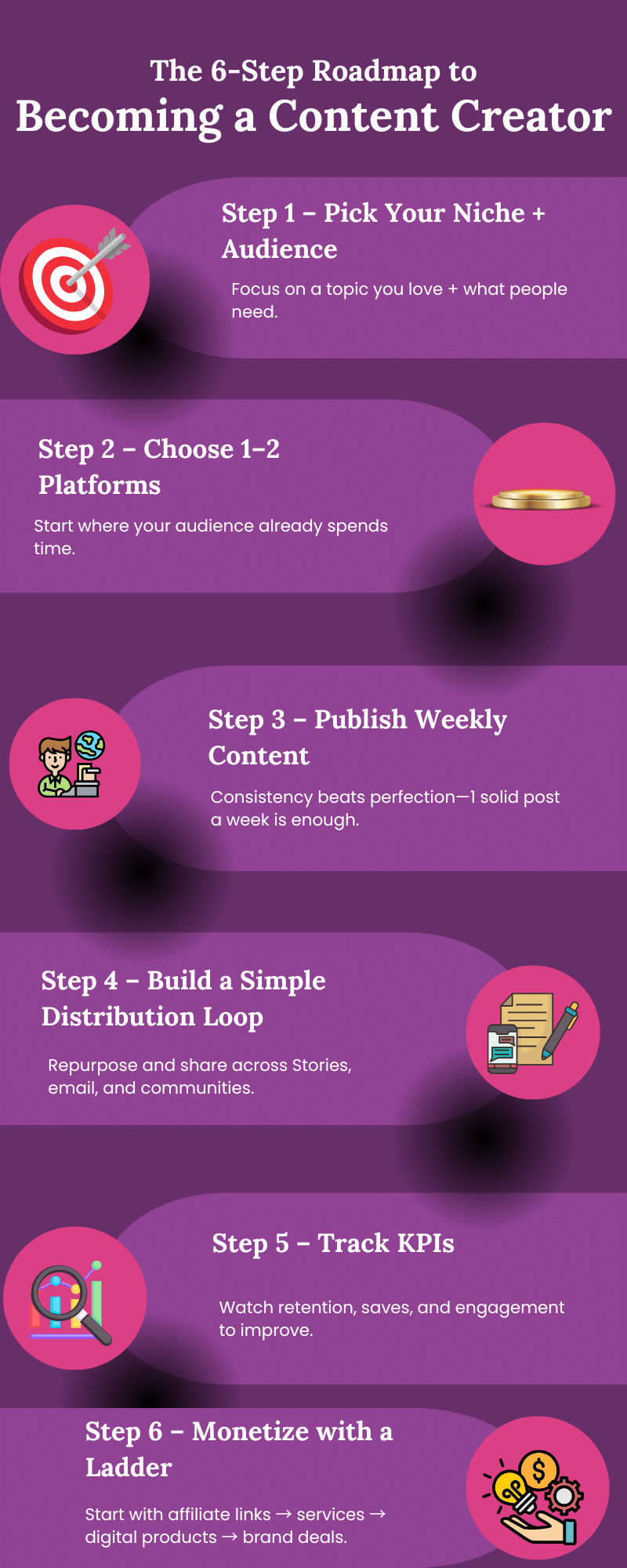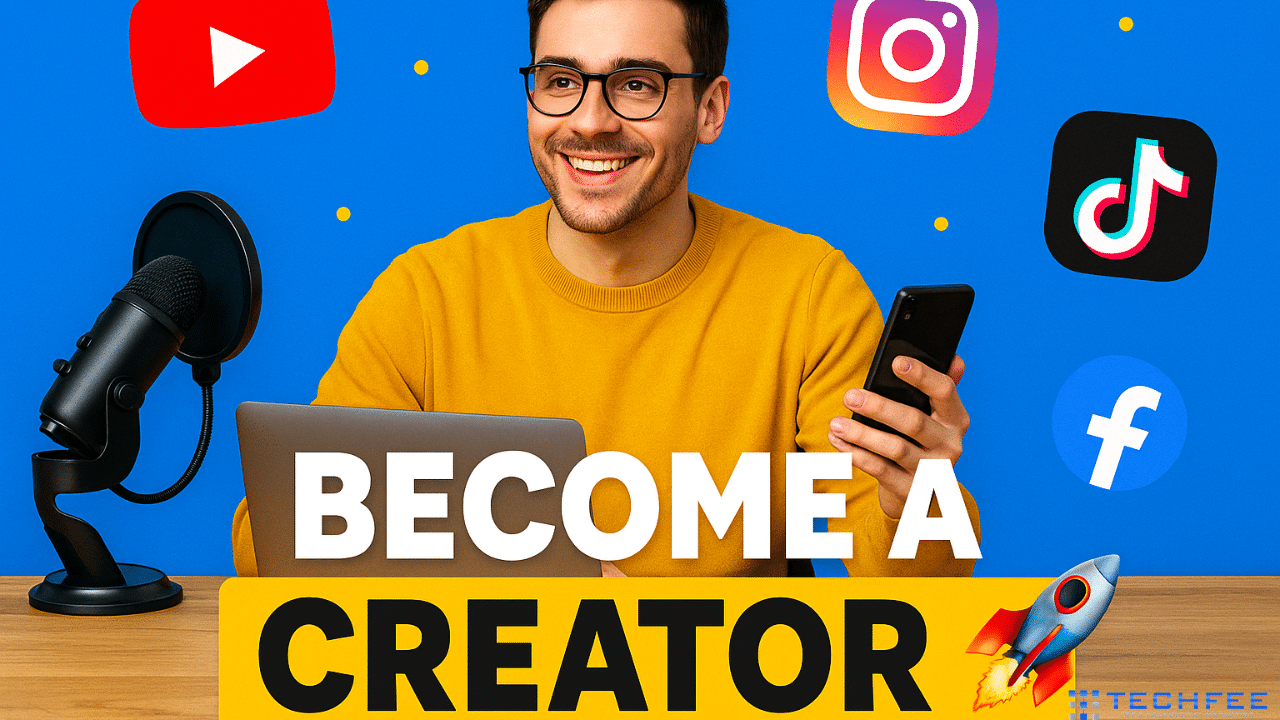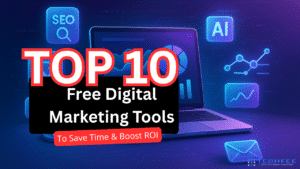Do you also dream of turning your passion for creating videos, writing posts, or sharing ideas online into a full-time career? If you’ve ever wondered how to become a content creator, you’re not alone.
In today’s digital age, content creation has become one of the fastest-growing career paths globally, with millions of people building loyal audiences and earning income from platforms such as YouTube, Instagram, TikTok, and blogs.
According to Demandsage, by 2025, the creator economy is expected to be booming, with over 207 million active content creators worldwide, and nearly 47% of them already making a full-time income.
What once started as a hobby has now become a powerful medium for building influence, growing a brand, and achieving financial independence.
But here’s the truth: most beginners don’t know where to start, what tools they need, or how to actually make money from their content.
That’s why I have written this guide for you. In this article, you’ll discover a complete roadmap on how to become a full-time content creator — from understanding what content creation really means, to choosing your niche, picking the right platforms, building a consistent strategy, growing an engaged audience, and finally, monetizing your work.
Whether you’re a beginner with no experience, someone creating content on the side, or an aspiring full-time digital entrepreneur, this step-by-step guide will show you exactly how to build your brand and turn your creativity into a career.
Keep reading, because by the end, you’ll have a clear action plan to start your journey today.
What Does “Content” Mean Today?

In today’s digital world, the word “content” simply means any piece of information created to inform, entertain, or inspire an audience.
This could be a YouTube video, a blog post, a podcast episode, an Instagram Reel, or even a 30-second TikTok short. Content is everywhere—and it’s the fuel that drives conversations, engagement, and ultimately, growth online.
So, what is a content creator? A content creator is someone who consistently produces and shares this type of content with a specific audience in mind. Unlike influencers, who often focus on promoting lifestyles or products, content creators are usually more focused on storytelling, education, and providing real value.
They also differ from traditional marketers, who create content for a brand, and from UGC (user-generated content) creators, who make content specifically for brands to use in their own marketing.
Today, we also talk about digital content creators—people who use multiple platforms to share their work, track performance with analytics, and build brand-safe content that aligns with community guidelines and audience trust.
Whether you’re posting short videos on social media, writing long-form blogs, or designing infographics, digital creators blend creativity with strategy to stand out in an increasingly crowded online space.
The 6-Step Roadmap

If you’re wondering how to start as a content creator, the process doesn’t have to feel overwhelming. In fact, you can follow a simple 6-step roadmap that many successful creators use to grow:
Pick a niche and audience – Focus on a topic you care about and a group of people who need it.
Choose 1–2 platforms – Start where your audience spends the most time instead of trying to be everywhere at once.
Publish weekly content – Consistency matters more than perfection; one good post a week is better than none.
Build a simple distribution loop – Share your content across multiple touchpoints (social posts, stories, email, communities) to get it seen.
Track KPIs – Watch metrics like views, saves, comments, and engagement to learn what works.
Monetize with a ladder – Start small with affiliate links or services, then move into digital products, brand deals, and other income streams.
This roadmap gives you a clear, action-ready answer to how to be a successful content creator without overcomplicating the journey.
Original vs Curated vs “Questionable” Content (Must-Know)
As a creator, it’s important to understand the difference between the types of content you’ll come across.
Original content is what you produce yourself—your own videos, blogs, or graphics built from scratch.
This is usually the most powerful because it showcases your unique voice and creativity.
Then there’s curated content. This is when you share someone else’s work—like an article, video, or infographic—while adding your own commentary or perspective.
Curated content works well to keep your audience informed, spark discussions, and show that you’re plugged into your industry. Just remember: always credit the original creator and add value instead of just reposting.
On the flip side, beware of questionable content. This includes clickbait that overpromises but underdelivers, misleading claims, copyrighted material used without permission, or anything that violates platform policies.
Posting this kind of content can harm your brand, damage trust with your audience, and even get your account flagged or banned. To stay brand-safe, follow community guidelines, respect copyright laws, and disclose when content is sponsored or affiliate-based.
Knowing when to create, curate, and avoid questionable content is a key step in building credibility and long-term growth as a content creator.
Is Content Creation Right for You? Skills, Time & Mindset
Before diving in, ask yourself if you’re prepared for what content creation really takes.
At its core, successful creators share a few key skills: strong communication to tell stories clearly, curiosity to keep learning and experimenting, audience understanding to know what people actually want, consistency to show up regularly, and basic analytics skills to track what’s working and what’s not.
But skills alone aren’t enough—you’ll also need the right mindset. Content creation takes time, patience, and the willingness to build habits that compound over months, not days.
Beginners often expect overnight success, but the truth is growth usually comes from steady effort and small wins that add up.
Creating one piece of content a week, analyzing the results, and improving the next one is far more effective than burning out trying to post daily without a plan.
If you’re just starting out, focus on building these habits first. They’ll help you improve your content creation over time and lay the foundation for growing into a full-time creator.
Find Your Niche + Audience (Fast Niche Fit Formula)
One of the first steps to grow as a content creator is finding the niche and audience that fit you best.
The easiest way to do this is by using the Intersection Method: pick a topic you genuinely love, check if there’s enough market demand for it, and make sure there are clear ways to monetize it in the long run.
For example, if you love fitness, notice whether people are actively searching for workout routines and if you can later sell products, coaching, or courses around it.
Doing some simple research makes this process faster.
Look at “People Also Ask” questions on Google, scan Reddit or Quora threads for common struggles, check YouTube or Instagram comments to see what audiences complain about, and study competitors to spot the gaps they’re not covering. These clues will show you exactly what people want.

Finally, define your Ideal Consumer Persona (ICP): who they are, what problem they face, what promise your content delivers, and what proof you can share to back it up.
When you know your audience this clearly, you can create content that resonates—and that’s the fastest way to build authority in your niche.
Pick Your First Platforms (Start Narrow, Win Faster)
When you’re just starting out, the biggest mistake is trying to be everywhere at once. Instead, choose one or two platforms where your audience already spends time and focus on mastering them first. Here’s a quick breakdown:
YouTube
Perfect for long-form tutorials and Shorts. It offers evergreen SEO—meaning your videos can rank and bring in views for months or even years. Great if your niche involves education, reviews, or step-by-step guides.
Best for Reels and Carousels. With strong visuals and short-form videos, Instagram is a hub for brand collaborations and conversions through DMs. A good choice if your niche thrives on visuals, lifestyle, or inspiration.
TikTok
Ideal for riding trends with quick, catchy content. TikTok’s short-form hooks and viral nature can help you grow fast. In some regions, live shopping is also available, making it a potential revenue stream.
Still powerful for building local and niche communities. Groups and Reels work well, and you can funnel page followers into your email list or newsletter for long-term growth.
Blog/Newsletter
The most important owned platform. Blogs drive traffic through SEO, while newsletters let you build direct relationships with your audience. Both are crucial for long-term monetization and stability beyond social algorithms.
👉 If you’re a beginner, start with YouTube + Instagram or TikTok + Blog, depending on your niche. These pairs balance discoverability, quick engagement, and long-term growth—helping you become a content creator on social media without burning out.
Your Simple Content Strategy (1-Page Plan)
You don’t need a complicated system to succeed—just a simple content strategy that fits on one page. Start by defining your goal: do you want to build awareness, capture leads, or drive sales? Ideally, you’ll aim for all three, moving your audience up the ladder step by step.
Next, create 3–5 messaging pillars to guide everything you publish. For example:
Educate – share tips or tutorials.
Demonstrate – show your process, tools, or products in action.
Proof – highlight results, testimonials, or case studies.
Community – share personal stories, behind-the-scenes, or audience shoutouts.
Keep your cadence simple but consistent. A great starting point is 2 Shorts or Reels plus 1 long-form piece per week. That’s manageable, yet enough to keep you visible.
Plan everything in a content calendar: brainstorm ideas → write scripts → record → edit → publish → repurpose. Repurposing is key—one video can turn into a Reel, a blog snippet, and a story.
Finally, set up a distribution loop. Don’t just hit publish; share the content as a native post, turn it into Stories, send it through email, and post it in communities. This ensures your work reaches more people without needing to create from scratch every time.
This one-page approach gives you a repeatable content marketing strategy, making it easier to generate ideas, stay consistent, and grow faster.
Gear & Tools on Any Budget (Face & Faceless Options)
A common question beginners ask is: “What do I need to be a content creator?” The good news is, you don’t need fancy equipment to get started.
Most creators begin with just a smartphone, a clip-on microphone for clear audio, some basic lighting (like a ring light or even natural sunlight), and a free video editor such as CapCut or DaVinci Resolve. For visuals, Canva is a go-to tool for designing thumbnails, graphics, and social media posts.
If you’d prefer not to be on camera, there are plenty of faceless content creation options. You can record your screen to make tutorials, use b-roll footage with captions, create product demos, design simple animations, or rely on whiteboard explainers.
Adding text-to-speech (always keeping it brand-safe) is another way to produce content without showing your face.
Whether you want to appear on screen or stay behind the scenes, today’s tools make it easy to start creating without breaking your budget. The real investment isn’t in expensive gear—it’s in your consistency and creativity.
Production Workflow You Can Stick To
If you’re a beginner wondering how to become a content creator for social media, the secret isn’t expensive gear—it’s having a simple, repeatable workflow. Start with a Hook → Value → CTA scripting template. Grab attention in the first 3 seconds, deliver one clear piece of value, and end with a strong call-to-action (like follow, share, or visit your site).
Make your process easier by batch filming. Take one content idea and turn it into three formats: a long-form YouTube video, a short-form Reel or TikTok, and a carousel post for Instagram or LinkedIn. This way, you maximize output without creating from scratch every time.
Follow a quality checklist before publishing: is there a strong hook upfront, one promise and one outcome per piece, easy-to-skim visuals, and a clear CTA? If yes, you’re ready to post.
Finally, don’t forget accessibility. Add captions for people watching without sound, use clear audio, and ensure your text is readable on mobile screens. This small step widens your reach and makes your content more professional.
A consistent workflow like this saves time, keeps you on track, and makes it easier to stick with content creation long term.
Growth Metrics That Matter (And What to Fix)
If you want to grow as a content creator, the key is to track the right metrics—not just vanity numbers like followers. In the early stages, focus on:
Publish velocity – how often you post new content.
Retention – how long people watch or read before dropping off.
Save rate – how many users bookmark your content for later.
Comments – signs of engagement and conversation.
Session time – how long your audience stays with your work.
When results aren’t what you expect, the signals will guide your fixes:
Low retention? Sharpen your hooks and deliver value faster.
Few saves? Create checklists, frameworks, or step-by-step content worth revisiting.
Low click-throughs? Test new thumbnails, titles, or opening lines.
Not many comments? End posts with clear prompts, polls, or open-ended questions.
By tracking these signals and making small adjustments, you’ll steadily improve your content creation and give platforms exactly what they want: valuable, engaging content that keeps people watching and interacting.
Monetization Ladder (From $0 → Full-Time)
If you’re serious about learning how to become a content creator and earn money, think of it as climbing a ladder. Each step builds on the last, moving you closer to becoming a full-time creator.
Phase 1 – Validate & Grow
Start small. Add affiliate links to products you already use and trust, or tap into platform ad revenue/bonuses like YouTube Partner Program or TikTok Creator Fund. This validates your niche and proves your content can generate income.
Phase 2 – Services & UGC
Once you’ve built some authority, offer services such as coaching, audits, or content strategy sessions. You can also create UGC (user-generated content) for brands—short videos, testimonials, or product showcases brands can use in their marketing. Freelance content packages are another quick way to get paid.
Phase 3 – Digital Products
Next, build scalable income with digital products: ready-to-use templates, mini-courses, eBooks, or membership sites. These allow you to serve a bigger audience without trading time for money.
Phase 4 – Brand Deals
At this stage, you’re ready for brand partnerships. Prepare a media kit and rate card, and learn the basics of pitching, usage rights, and whitelisting (when brands run ads using your content). This is where serious income opportunities open up.
👉 No matter which phase you’re in, always include ethical disclosures (affiliate disclaimers, “sponsored by” tags) and use UTM tracking links to measure what’s working.
By moving step by step up this ladder, you’ll know exactly how to become a content creator, make money, and work with brands in a sustainable way.
Portfolio, Pitches & Media Kit (No Experience? Do This.)
If you’re wondering how to become a content creator with no experience, the best way is to build a simple portfolio that proves your potential.
Start by creating a proof folder—collect your 5 best posts, add 2 short case-style breakdowns (what you created, why, and the results), and include before/after analytics if possible. Even small wins like increased engagement or improved click-through rates count as proof.
Next, craft a pitch template you can reuse when reaching out to brands or clients. Keep it structured:
Problem – What challenge the brand is facing.
Idea – How your content can solve it.
Deliverables – What you’ll provide (posts, videos, graphics).
Timelines – How fast you’ll deliver.
Price – Your fee or package.
Proof – Results from your portfolio folder.
Finally, put together a basic media kit. This should include your niche, audience demographics, engagement stats, content formats you create (Reels, blogs, videos, etc.), pricing, and any past collaborations.
Even if you’re just starting, showing structure and professionalism makes you look like a serious content creator startup ready for opportunities.
The 30-60-90 Day Plan to Go Full-Time
If you’re serious about learning how to become a full-time content creator, you need a clear action plan. Here’s a simple 90-day roadmap you can follow:
Days 1–30: Lay the Foundation
Choose your niche and commit to 1–2 platforms.
Publish 8–12 posts to test what resonates.
Learn the basics of hooks, titles, and thumbnails to grab attention.
Set up a basic affiliate system to start experimenting with monetization.
Days 31–60: Build Consistency & Authority
Start batching content to save time and reduce stress.
Collaborate with at least two creators in your niche to expand reach.
Create your first email lead magnet to grow an owned audience.
Launch your first service or UGC offer to test direct income.
Days 61–90: Scale & Monetize
Launch your first digital product (eBook, template, or mini-course).
Pitch 10 brands with your media kit to explore paid collaborations.
Analyze and optimize your top 5 performing posts for even better results.
Double down on content that drives the highest retention and engagement.
By the end of 90 days, you’ll have a system in place, a growing audience, and your first income streams—real steps toward being a full-time content creator.
Common Mistakes & “Questionable” Tactics to Avoid
If you want to know how to be a successful content creator, it’s just as important to avoid the traps that hold many beginners back. A few to watch out for:
Clickbait without payoff – Grabbing attention with a flashy headline but delivering no real value only damages trust.
Copying content – Repurposing ideas is fine, but directly copying others will hurt your credibility and growth.
Ignoring analytics – Without tracking performance, you’ll miss the insights that show what’s working and what’s not.
Violating platform policies – Posting questionable content that breaks rules can lead to shadow bans or account suspension.
No disclosures – Always be transparent with affiliate links and sponsorships to build long-term trust.
Over-relying on AI without editing – AI tools can help, but unedited AI content often feels robotic and risks being flagged.
Burnout (no systems) – Posting daily without a workflow or batching strategy leads to exhaustion and inconsistency.
Avoiding these mistakes keeps your content authentic, compliant, and sustainable—three qualities every successful creator needs.
Conclusion on How to Become a Content Creator
Becoming a content creator may feel overwhelming at first, but when you break it down, the path is clear: choose your niche, focus on 1–2 platforms, create consistently, track what works, and climb the monetization ladder step by step.
With the right skills, mindset, and systems, you can turn your creativity into a brand—and eventually a full-time career.
The most important part? Taking the first step. Publish that first post, record that first video, or share that first story. Every successful creator you admire started exactly where you are now.
Your brand, your audience, and your future are waiting. Start today.
I’d love to hear from you—drop your thoughts, questions, or experiences in the comments below. Don’t forget to subscribe to the blog or join our email list for more digital marketing and content creation tips. And if you found this guide useful, share it with a friend or fellow aspiring creator who’s ready to begin their journey too.
Finally, do a fellow creator a favor: share this guide with someone who wants to grow as a content creator. Together, we can help more aspiring creators cut through the noise and build content that truly connects.
Frequently Asked Questions
How do I become a content creator with no experience?
Start small by picking a niche you enjoy, post consistently on 1–2 platforms, and learn by practicing. Build a simple portfolio from your best posts to show credibility.
What do I need to start as a content creator?
A smartphone, a basic mic, good lighting, and free tools like Canva or CapCut are enough to begin. What matters most is consistency, not expensive gear.
How can I become a content creator without showing my face?
Use screen recordings, b-roll with captions, product demos, whiteboard explainers, or animations. Faceless content works just as well if it delivers value.
How do content creators make money?
Through affiliate links, ad revenue, services (like coaching or UGC), digital products, and brand collaborations. Most creators start small and scale step by step.
Is content creation saturated in 2025?
It’s competitive but not saturated. There’s always room for fresh voices who solve real problems or share unique perspectives in their niche.
How long does it take to go full-time?
On average, 6–12 months with consistent effort, but it depends on niche, strategy, and how quickly you monetize. Some take longer; a few grow faster.
What’s the difference between content marketing vs digital marketing?
Content marketing focuses on creating valuable content to attract and engage an audience. Digital marketing is broader, covering paid ads, SEO, email, and all online channels.
What is curated content and when should I use it?
Curated content is sharing someone else’s work with proper credit while adding your insights. Use it to fill gaps, spark discussions, or provide extra value for your audience.
Free Templates & Resources
Getting started as a creator is easier when you have the right tools at hand. To save you time, we’ve put together a free starter pack that includes:
A 30-day content calendar (Google Sheet) to plan and stay consistent.
A media kit outline (Canva template) to showcase your brand to potential partners.
A brand pitch email template (ready-to-use Gmail draft) for reaching out to sponsors.
A monetization ladder checklist to track your journey from $0 to full-time income.
👉 Want these resources? Get the pack free—just join the Techfee newsletter. You’ll receive in weekly tips, insights, and strategies to guide your growth, covering everything from content marketing basics to advanced strategies.
Subscribe Now









